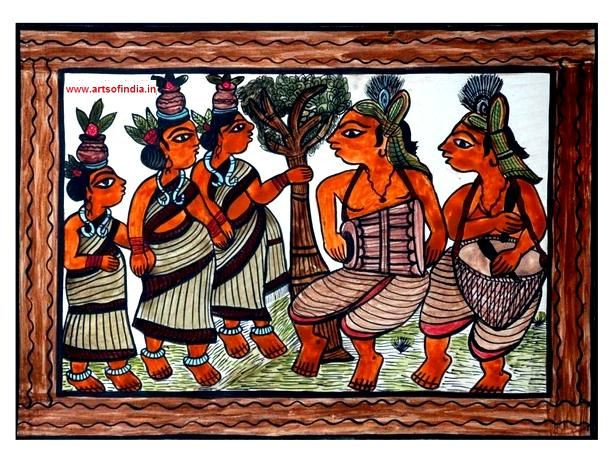Owing to a diverse range of tribal groups residing in India, several forms of tribal paintings have evolved here. A few of them are mentioned below.
- Warli Folk Paintings: Originated from Maharashtra, it is famous for its wall paintings of geometrical shapes and patterns like circles, squares, triangles, and so on.
- Madhubani Art: Originated from Bihar, these paintings are created on mud walls that are freshly plastered. They involve pictures of Shiva, Saraswati, Krishna, Durga, Sun, Moon, flowers, trees, animals, etc.
- Gond Art: Originated from Madhya Pradesh, they are curved on mud walls, canvas, clothes or paper, and have many details, colours, dots, lines, dashes, humour, and mystery.
- Bhil Art: Originated from the tribal community of the Central belt of India, these paintings have dots in various colours and include the carvings of nature, Gods, Sun, Moon, etc.
- Tanjore Paintings or Thanjavur Paintings: Originated from the Maratha Court of Thanjavur, these paintings are famous for the use of stones, glass, gold foils, and vibrant colours in their work. They are made on wooden boards and mostly depict Hindu Gods and Goddesses.
- Saura Paintings: Also known as Ikons, these paintings have a backdrop of yellow ochre or red. It has very simple figures which depict the lives of village farmers. They originate from the eastern part of India.
- Khovar Art: “Kho” or “Koh” means caves and “Var” means husband. These matriarchal paintings are done by women during the harvest season and have the carvings of various animals. They originate from the Hazaribagh district of Jharkhand.
- Pattachitra Paintings: Originated from Odisha, these paintings are generally done on clothes that portray Gods and Goddesses, with fine sharp lines in bold colours and floral designs at the borders.
- Kavad or Kawad Art: Originated from Rajasthan, these paintings are three-dimensional boxes that have multiple panels, which can be unfolded. They are portable temples, where different Gods and Goddesses are painted.
- Kalamezhuthu Art: “Kalam” means picture and “ezhuthu” means drawing, these paintings have their own way of drawing. They are done on the floor and can be seen during special occasions or festivals. They originate from Kerala.
- Paitkar Painting: Originated from West Bengal, this painting is an expression of folk arts. It is also known as the "Scroll Painting" of the East and is based on the themes from the Hindu epics. Most of the space here is full of human characters with elongated eyes. Mostly, primary colours are used with palm leaves as the base.
- Santhal Painting: Primary colours are used in these paintings with leafy patterns everywhere. They have the features of directness and simplicity with animals, birds, and insects in them. The figures are multicoloured, static, and artistic. They are drawn in black first and then coloured. Earlier, natural colours from stones and plants were used but now, synthetic colours are mostly used. The paintings portray strong family bonds and a philosophy of unity and love. They are found in the states of Bihar, West Bengal, and Jharkhand.
- Tikuli Painting: These are very uncommon hand paintings, which got their name from "Bindi" or "Tikli". The paintings involve dissolving glasses, blowing them into flimsy sheets, making designs in hues, and decorating them with gems and gold thwarts. Its origin is from Patna.
- Sohrai Painting: Originated from Jharkhand, these paintings are made on mud walls of the homes by tribal women, portraying flowers, peacocks, squirrels, birds, elephants and other animals with white, black and red colours. The paintings are done to celebrate the harvests and as a thanksgiving to nature.
Contemporary significance
The tribal paintings still hold relevance with today’s world. In these times of surging digital media presence, the tribal paintings instill emotions linked with the paintings, showcasing the deep-rooted culture and diversity from every corner of India.
Beyond culture, the paintings portray the way of life that the tribal people led through various art forms, each one requiring different skills which at that time was mostly self-taught. These tribal paintings or rather masterpieces are helping today’s generation to lay low and hold on to our roots firmly which otherwise would have been long lost.
Picture Source: ArtsofIndia.in



